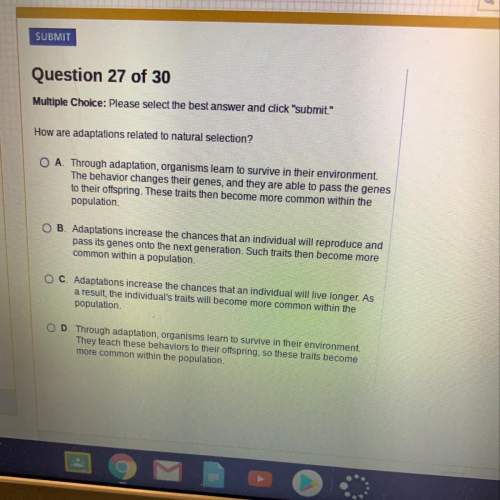
Biology, 28.12.2019 05:31 proutyhaylee
Environmental stimulation during childhood often contributes to the development of intelligence by altering the circuitry of the brain. this alteration illustrates

Answers: 3


Other questions on the subject: Biology

Biology, 21.06.2019 23:00, tommyaberman
Use the drop down menus to match each example to the fossil topic discussed then to show how the fossil record gives evidence of evolution
Answers: 1

Biology, 22.06.2019 00:30, Likat681
What is the difference between the conducting zone and the respiratory zone of the respiratory system? the conducting zone is a series of cavities and tubes that move air to the respiratory zone where gases exchange with the bloodstream. the conducting zone exchanges gases between the lungs and the alveoli and the respiratory zone is a series of cavities and tubes that move air to the conducting zone. the conducting zone moves oxygen into the cells and the respiratory zone takes carbon dioxide away from the cells. the conducting zone moves oxygen into the bloodstream and the respiratory zone takes carbon dioxide away from the bloodstream.
Answers: 2

Biology, 22.06.2019 01:00, Samuelgamboe
The sketch shows a rynchosaur, an extinct animal that is known only from fossils. there has been much debate about the classification of these creatures. some scientists suggest that they belong with primitive amphibians, and some think they are related to snakes and lizards. the data equally support both cases. which statement best explains how to draw a cladogram that includes the rynchosaur? draw the cladogram for amphibians. draw the cladogram for reptiles. draw two cladograms, both showing the traits, and leave it as a hypothesis. draw two cladograms, both showing the traits, and have scientists vote
Answers: 2

Biology, 22.06.2019 14:30, shaferxspecial3737
What is a difference between systemic and pulmonary circulation? a. systemic circulation carries oxygenated blood to the lungs and pulmonary circulation carries deoxygenated blood to the body. b. systemic circulation carries deoxygenated blood to the lungs and pulmonary circulation carries oxygenated blood to the body. c. systemic circulation carries deoxygenated blood to the body and pulmonary circulation carries oxygenated blood to the lungs. d. systemic circulation carries oxygenated blood to the body and pulmonary circulation carries deoxygenated blood to the lungs.
Answers: 1
You know the right answer?
Environmental stimulation during childhood often contributes to the development of intelligence by a...
Questions in other subjects:


English, 11.03.2020 07:24

Social Studies, 11.03.2020 07:24


Mathematics, 11.03.2020 07:24

Chemistry, 11.03.2020 07:25




Mathematics, 11.03.2020 07:25




